Post cool photo's of WW2 Machines/Engineering
Discussion
Apache said:
Known as the Westland P.12 or "Wendover", it had a mock up of a heavy bombers rear turret in plywood to test the flying characteristics, it flew very well and even performed a loop on it's first test flight. Not designed as you might think as a bomber gunners practice platform but as a proper plane originally to attack German invasion barges and with the turret to strafe ships and ground troops.JonRB said:
Eric Mc said:
There must have been genuine reasons why these "turbo-compound" engines were used.
Perhaps turbo-charging technology was in its infancy at the time and total reliance on the "turbo" element was judged to risky.
My understanding was that the two different methods of forced induction gave different benefits at different altitudes / scenarios, and added together gave a superior package than just using one or the other. Perhaps turbo-charging technology was in its infancy at the time and total reliance on the "turbo" element was judged to risky.
Eric Mc said:
Sorry, being geeky is a priviledge so don't hide the geekiness. A person earns more kudos by getting the facts right  .
.
The concept of the Stuka came directly from the experience of dive bombing techniques promulgated by former WW1 air ace Ernst (another one) Udet. He visited the US in the 1930s and was given the opportunity to fly their Curtiss Hawk biplane. He was impressed by its stability in a dive and argued the case that, for tactical bvombing purposes, the idea of being able to dive directly at the target would improve accuracy. The Stuka concept grew out of this.
I'm not sure that the visit to America was THAT influential. .
.The concept of the Stuka came directly from the experience of dive bombing techniques promulgated by former WW1 air ace Ernst (another one) Udet. He visited the US in the 1930s and was given the opportunity to fly their Curtiss Hawk biplane. He was impressed by its stability in a dive and argued the case that, for tactical bvombing purposes, the idea of being able to dive directly at the target would improve accuracy. The Stuka concept grew out of this.
The luftwaffe had ordered dive bombers (both light and heavy) before Udet flew the hawk biplanes.
It may well have reinforced their decision to order though.
BruceV8 said:
Callan.T89 said:
This is a Cent AVRE that made it to the first Gulf War, but not home. Centurions had Meteor petrol engines. And here's what happens when you clean that engine with petrol. Or, as has been alleged, cook your breakfast on the vehicle next to he fuel filler.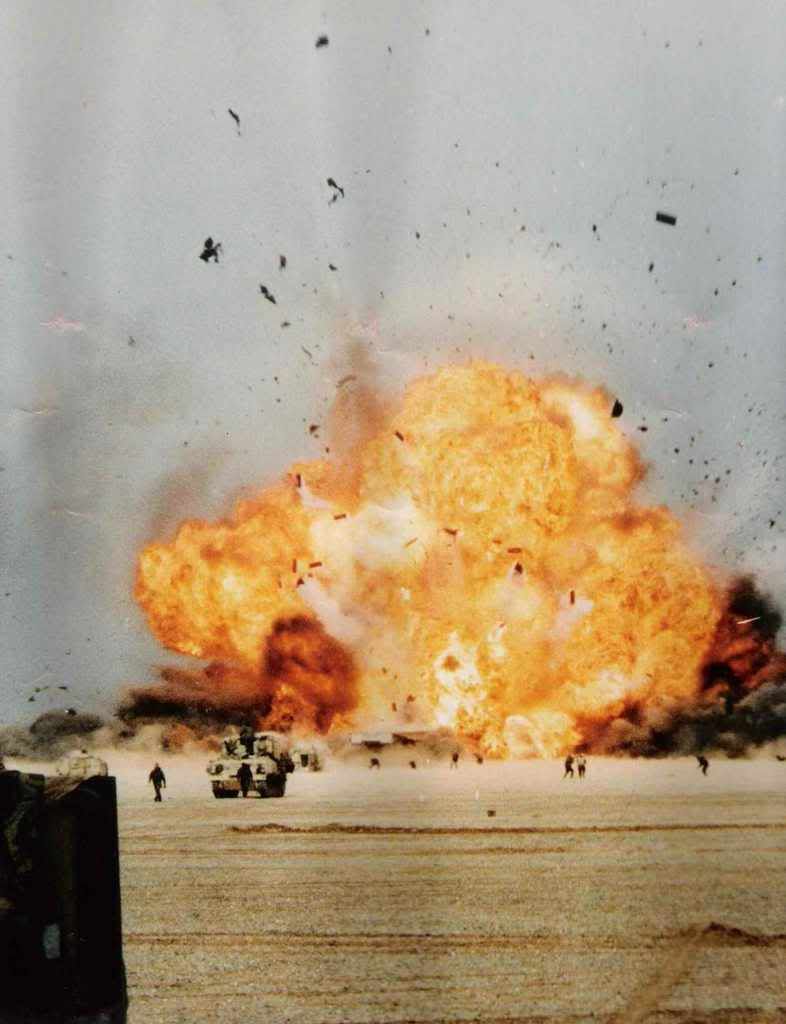
The Centurion in the picture did actually make it home and was restored by some BBC engineering programme in about 2000. Doesn't really matter though was just making the point that 45 years after it entered service the base design was still in use despite it being seperseeded twice (Cheiftain and Challenger)
Callan.T89 said:
minimatt1967 said:
Eric Mc said:
Where it all began. The RAF's first turret eqiuipped aircraft - the Overstrand, designed and built by Boulton Paul

Its still staggers me how far technology went in a short space of time!
From that to..

In less than 10 years!
Like these:
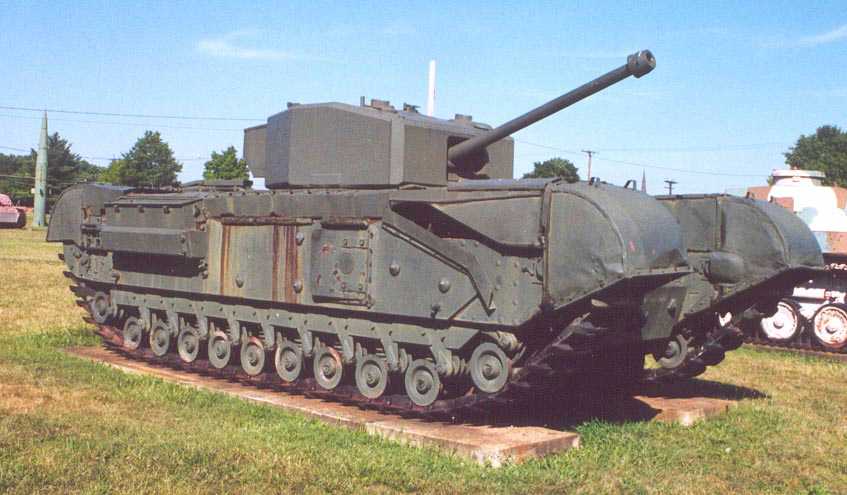
This to this in WW2 timeframe.

Which was still being used in the 1st Gulf war.
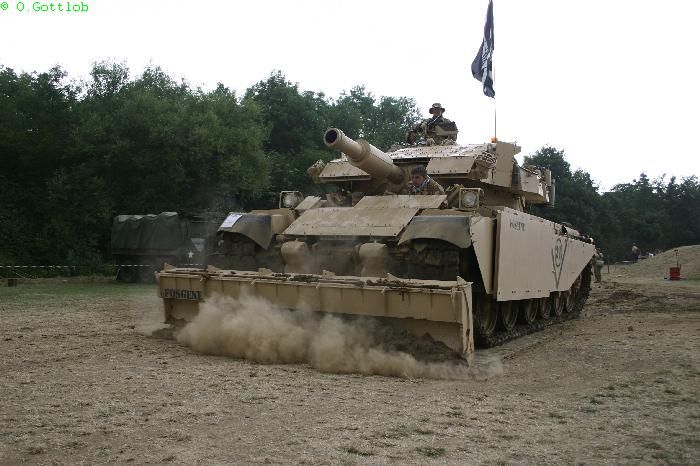
Here's a bit I found on the net.
Centurion registration number 01 ZR 15 entered service with the British Army in 1949 and saw action in Suez in 1956. During the early 1960s it was converted to an AVRE (Armoured Vehicle Royal Engineers – a special tank used by the Royal Engineers) and took part in the Gulf War in 1990. At that time it was the oldest vehicle in service with the British Army. It was decommissioned in the mid-1990s and has been out of action for the last five years.
eccles said:
Eric Mc said:
Sorry, being geeky is a priviledge so don't hide the geekiness. A person earns more kudos by getting the facts right  .
.
The concept of the Stuka came directly from the experience of dive bombing techniques promulgated by former WW1 air ace Ernst (another one) Udet. He visited the US in the 1930s and was given the opportunity to fly their Curtiss Hawk biplane. He was impressed by its stability in a dive and argued the case that, for tactical bvombing purposes, the idea of being able to dive directly at the target would improve accuracy. The Stuka concept grew out of this.
I'm not sure that the visit to America was THAT influential. .
.The concept of the Stuka came directly from the experience of dive bombing techniques promulgated by former WW1 air ace Ernst (another one) Udet. He visited the US in the 1930s and was given the opportunity to fly their Curtiss Hawk biplane. He was impressed by its stability in a dive and argued the case that, for tactical bvombing purposes, the idea of being able to dive directly at the target would improve accuracy. The Stuka concept grew out of this.
The luftwaffe had ordered dive bombers (both light and heavy) before Udet flew the hawk biplanes.
It may well have reinforced their decision to order though.
However, another factor in the dominance of dive-bombing in the Luftwaffe's philosophy was the death of General Wever in an air crash in the 1930s. Wever was an ardent supporter of long range strategic bombing and he might have been able to mount a counter argument to the dive-bombing propaganda had he lived. Once he was gone, strategic bombing had no champion in influental circles.
Mr_B said:
Remember that Channel 4 show called Salavge Squad ? They restored an old Centurion and found the crew that saw service with it in the first Gulf war. Quite a good show that one.
Here's a bit I found on the net.
Centurion registration number 01 ZR 15 entered service with the British Army in 1949 and saw action in Suez in 1956. During the early 1960s it was converted to an AVRE (Armoured Vehicle Royal Engineers – a special tank used by the Royal Engineers) and took part in the Gulf War in 1990. At that time it was the oldest vehicle in service with the British Army. It was decommissioned in the mid-1990s and has been out of action for the last five years.
That was the one I saw, remember the name now, the Centurion pictured was the one restored by salvage squad and this picture was taken at a militay show afterwards. Here's a bit I found on the net.
Centurion registration number 01 ZR 15 entered service with the British Army in 1949 and saw action in Suez in 1956. During the early 1960s it was converted to an AVRE (Armoured Vehicle Royal Engineers – a special tank used by the Royal Engineers) and took part in the Gulf War in 1990. At that time it was the oldest vehicle in service with the British Army. It was decommissioned in the mid-1990s and has been out of action for the last five years.
Callan.T89 said:
A little unfair on the Churchill - it was never intended to do what the Cent was. It was pretty sound design for it's intended battlefield role.The Cent wasn't really a revolution either - you can trace it's roots right back to the A13 Cruiser, the first British tank to use the Christie system. It became the first Main Battle Tank more by accident - they were trying to give a Cruiser Tank the toughness of an Infantry Tank.
The basic Centurion hull design is in combat today - literally. The Israelis converted all their old Sh'ot Cals into APCs...
s2art said:
I dont think they ever used both a turbine and a direct drive supercharger together. Turbo-compounding just means taking a drive off the turbine.
They did indeed use both. The P-47 had a single stage supercharger on the engine as did several other types. The B-24, B-17, and B-29 certainly did.The later B-36 actually had 2 turbochargers and a supercharger for each engine, and at high altitude, the low air density did not give enough exhaust flow to operate both turbos, so all the flow was switched to one.
Turbocompounding, where a recovery turbine couple to the crankshaft was used after the war in some civilian aircraft like the Super Constellation and the DC-7.
Here are a few diagrams:
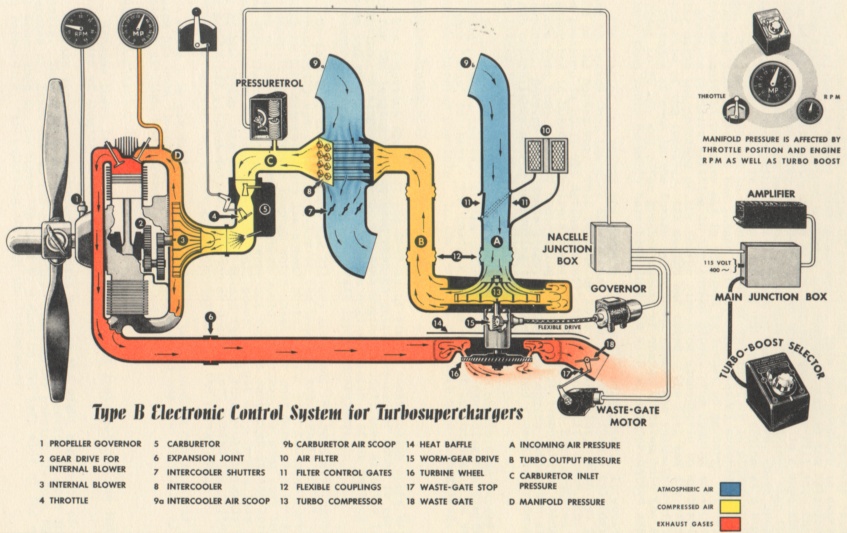
P-47 installation:
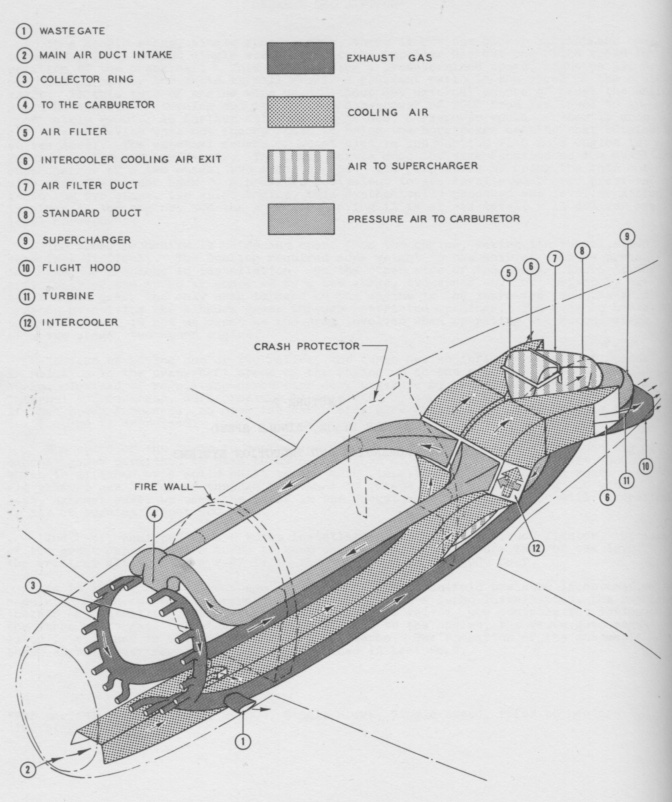
B-24:
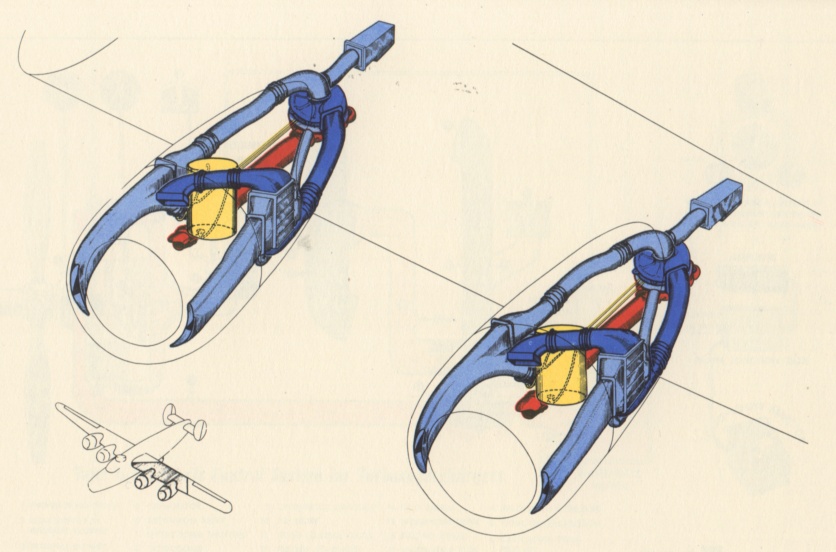
Dunk76 said:
BLUETHUNDER said:
T.B.H all allied tank design during the war was woefully inferior to what the Germans were producing.If only the Britsh could have got the Centurion out a couple of years earlier,then i think the battle of the Falaise gap would have had a different outcome.
Not strictly true - the British designs were generally very sound in theory but suffered from under-gunning caused by turret ring size issues and a lack of dual-purpose or HE capability until the M3 and M4 appeared.The main issue for British armour was the way it was handled...
Cruiser tanks used for assaulting fixed infantry positions - as at Huppy in 1940, and repeatedly in the Desert - and Infantry tanks in tank-tank action as per the Desert and Operations Goodwood and Epsom was only going to go one way.
My Grandfather, in Churchills with Guards Armoured Div in 1944, recalled the genuine surpise at very senior levels at the amount of hedgerows in Normandy. The 7th Armoured, flush from their sweeping victories in the desert came off very badly as their commanders struggled to get to grips with the terrain and close infantry co-ordination.
The inter-war budget cuts and marginalisation of Liddell-Hart and the other armoured theorists (Guderian's Blitzkrieg concept was the final development of British theories), coupled with the traditional British Regimental system which prevented cross-fertilisation of ideas, meant an awful lot of good men died needlessly.
Edited by Dunk76 on Thursday 1st January 22:46
We were still building Valentines in 1944 because we couldn't think of anything better to do...and it was only with the Comet that we came close to the performance of the Panther - or even a late Type IV.
Had we pulled our fingers out then the majority of the Shermans landed in Normandy could have been Fireflies - and although we weren't helped by the Americans' insistence on 'tank destroyers', both the Russians and the Germans had left our concepts of separate 'Infantry' and 'Cruiser' tanks behind long before we managed to make the leap to Centurion.
And whilst the Centurion was pretty special in April 1945, it looked a bit sick next to the JS3 that the Russians rolled out for the Berlin victory parade a scant few weeks later.
Nick_F said:
I recommend A J Smithers' 'Rude Mechanicals' if you want to get really cross about British tank design; the ineptitude verged on criminal negligence.
We were still building Valentines in 1944 because we couldn't think of anything better to do...and it was only with the Comet that we came close to the performance of the Panther - or even a late Type IV.
Had we pulled our fingers out then the majority of the Shermans landed in Normandy could have been Fireflies - and although we weren't helped by the Americans' insistence on 'tank destroyers', both the Russians and the Germans had left our concepts of separate 'Infantry' and 'Cruiser' tanks behind long before we managed to make the leap to Centurion.
And whilst the Centurion was pretty special in April 1945, it looked a bit sick next to the JS3 that the Russians rolled out for the Berlin victory parade a scant few weeks later.
I'm as angry as it's possible to be without reading any more - but given the utter farces which came afterwards, the Chieftain engine being the most notable, nothing has ever been learnt. The design ineptitude is only the tip fo the iceberg - the meddling at every level was, and still is, the hallmark of almost everything the British armed forces have used... The chronic lack of AA Guns on RN Capital ships. The F4 Phantom engines. Cheap/Basic gunsights on all WW2 tanks. The Chieftain engines. Whittle being ignored. Private sponsorship for Merlin development. EE Lightning R&D having to be conducted in service by the RAF. Issuing PIATs in 44/45 when the Bazooka was readily available. It's a bloody marvel we've ever won anything and that our Defence Industry is the size it is.We were still building Valentines in 1944 because we couldn't think of anything better to do...and it was only with the Comet that we came close to the performance of the Panther - or even a late Type IV.
Had we pulled our fingers out then the majority of the Shermans landed in Normandy could have been Fireflies - and although we weren't helped by the Americans' insistence on 'tank destroyers', both the Russians and the Germans had left our concepts of separate 'Infantry' and 'Cruiser' tanks behind long before we managed to make the leap to Centurion.
And whilst the Centurion was pretty special in April 1945, it looked a bit sick next to the JS3 that the Russians rolled out for the Berlin victory parade a scant few weeks later.
Anyway, back to tanks - the Valentine only came into being because the Matilda II was too expensive/time-consuming to build. It certainly wasn't a bad tank but operationally it was finished as a frontliner by 1942.
That said, in a head-to-head, 1 on 1 fight, British Tanks were normally the equal of the Germans - until the Panther and Tiger appeared. Even the heavily uparmoured late Pz.IV couldn't stop a 6pdr round.
Edited by Dunk76 on Sunday 4th January 17:53
Dunk76 said:
A little unfair on the Churchill - it was never intended to do what the Cent was. It was pretty sound design for it's intended battlefield role.
True. Comparing fish with fowl. Cent Armoured Recovery Vehicles (ARV) were also in service into the 90s. I saw 3 ARVs at Shoeburyness in 1995 that were used for winching vehicles off the sand flats.

Cent Beach Armoured recover vehicles (BARV) were only retired in 2005. Not bad when you consider the hulls were built in 1945!
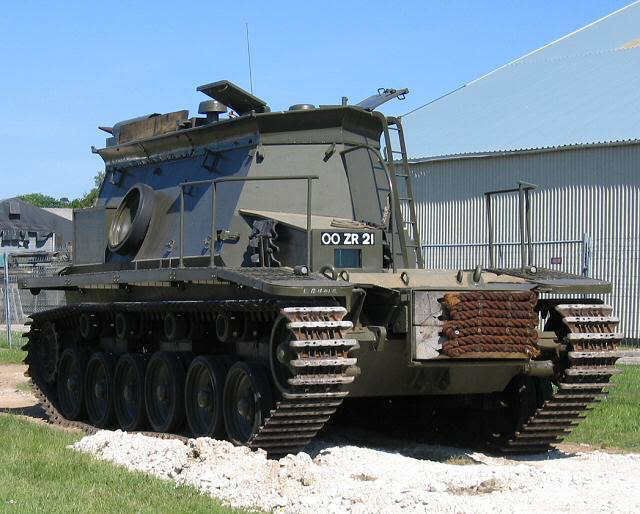
This is a BARV being used in the Falklands in 1982. BARVs were the only MBT size AFVs used by either side:

And the same vehicle in the Gulf:

Callan.T89 said:
Mr_B said:
Remember that Channel 4 show called Salavge Squad ? They restored an old Centurion and found the crew that saw service with it in the first Gulf war. Quite a good show that one.
Here's a bit I found on the net.
Centurion registration number 01 ZR 15 entered service with the British Army in 1949 and saw action in Suez in 1956. During the early 1960s it was converted to an AVRE (Armoured Vehicle Royal Engineers – a special tank used by the Royal Engineers) and took part in the Gulf War in 1990. At that time it was the oldest vehicle in service with the British Army. It was decommissioned in the mid-1990s and has been out of action for the last five years.
That was the one I saw, remember the name now, the Centurion pictured was the one restored by salvage squad and this picture was taken at a militay show afterwards. Here's a bit I found on the net.
Centurion registration number 01 ZR 15 entered service with the British Army in 1949 and saw action in Suez in 1956. During the early 1960s it was converted to an AVRE (Armoured Vehicle Royal Engineers – a special tank used by the Royal Engineers) and took part in the Gulf War in 1990. At that time it was the oldest vehicle in service with the British Army. It was decommissioned in the mid-1990s and has been out of action for the last five years.
Edited by BLUETHUNDER on Sunday 4th January 18:00
rhinochopig said:
BruceV8 said:
Callan.T89 said:
This is a Cent AVRE that made it to the first Gulf War, but not home. Centurions had Meteor petrol engines. And here's what happens when you clean that engine with petrol. Or, as has been alleged, cook your breakfast on the vehicle next to he fuel filler.
 That's a big bang. I might steal that pic for when I lecturing on Human Factors in the design of military kit. Making something sqauddie proof is tough.
That's a big bang. I might steal that pic for when I lecturing on Human Factors in the design of military kit. Making something sqauddie proof is tough.Gassing Station | Boats, Planes & Trains | Top of Page | What's New | My Stuff







